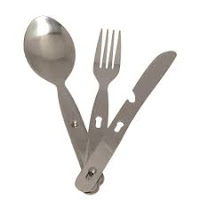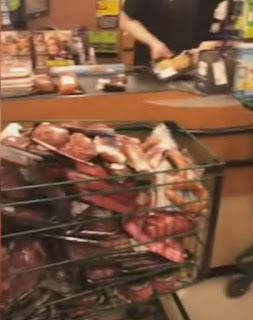Have you broken up with your bread before? You know, cause maybe you read that gluten is bad for you. Or maybe you figured you had a gluten intolerance or... well... something. Oh, I remember... bread is bad cause it's... gasp... a CARB!

Yeah, we broke up with our bread for a while. Out went the wheat flour and in came the weird things like oat flour, coconut flour and almond flour. Out went the bread and crackers and in came... well... no good bread replacement. Except Mary's Crackers which are amazing! We love Mary's crackers and the fact that they are gluten free is just a bonus.
Now, we didn't go bread free because of any allergies or intolerances... more because my partn... errr... one of us... had read on Pinterest that carb/gluten=bad. In case you missed it in an earlier blog post... Pinterest is NOT a reliable source for nutritional information. It's really more about click-bait.
I have to admit, I was a reluctant carb/gluten-free disciple... I didn't really see the whole hoopla about it. I did try to eat whole wheat bread not that [not so] Wonder [ful] white Bread stuff...
Now though... we are trying to eat a whole-foods, plant-based diet. Which means we should be eating around three servings of minimally processed whole-grains a day. Whole grains are a great source of protein, vitamins, good fats and... fibre! Oh great... more fibre for my little gut biome critters to munch on. Spoiler alert... it's not just beans that produce flatulence... unfamiliar whole grains do it too!
What is a "Whole Grain"?
 |
| Wikipedia - diagram of a grain |
What exactly is a "whole grain"? Well, it's a grain that has all three components: the endosperm, the germ and the bran. Huh?
The endosperm is the guts of the whole grain, the germ is the embryo of a new plant and the bran is the outer shell of the grain. I can picture that better if I think of a kernel of corn (which is a grain)... like when you eat corn on the cob. The skin of each kernel, the bit that gets stuck in my teeth, is the bran. The juicy inner bit is the endosperm. And those little firm bits that usually get left behind as I munch along the cob... but which I usually come back and pick out... that's the germ.
No surprise that most of the protein, fibre and vitamins are found in the bran and germ... much of which gets eliminated when grains are processed into flour. The germ in particular, because it contains good fats, oxidizes and goes rancid so it's almost always removed.
Whole Grains: Common as Hen's Teeth
Sooo... all we need to do is find some whole grains. Sounds simple enough. We just go out and buy some at the grocery store... but... turns out it's not so easy. Try it sometime, go into your favourite grocery store and look for whole-grains. Not processed stuff... just... whole grains. Where would you look? They're not down the aisle with the legumes. They're not down the rice aisle. They're not down the flour aisle? Where the heck are they?
First time I went looking, I found rice (white, brown, wild), quinoa and a tiny bit of farro. The rice was down the rice aisle (duh). But the quinoa and farro were with the noodle meal packets (things like Hamburger Helper). Interesting logic on the part of Superstore. But surely, there must be more whole grains than that?
Well yes... there are all sorts of wonderful things like: wheat (spelt, emmer, farro einkorn, Kamut, durum), rice (black, red and other colours), barley (hulled and dehulled but not pearl), maize (corn!), rye, oats (including hull-less or naked oats), millet, sorghum, teff, triticale, amaranth, buckwheat, quinoa and wild rice.
But where the heck were they? I paced through Superstore's bulk food section, studying each bin intently and eventually discovered they had buckwheat groats. Whole grains are sometimes called "groats" or "berries"... like oat groats or wheat berries. Since Superstore was a barren wasteland of whole grains... I tried other places.
I had more success at Bulk Barn and Country Grocer. There are options out there! Which is good because rice and beans was going to get really boring after a while.
So we have started dipping our toes into the whole grain palate... starting with farro (yummy) and buckwheat (interesting)... it gives us more options for spicing up various meals.
Fibre:Carb Ratio Trick
But... what about bread?? Leaving aside the whole gluten debate which, unless you are celiac, is really a tempest in a teacup... is bread a good carb or a bad carb? I went on the hunt and found a couple of helpful pieces of information.
The
Harvard Health blog suggests looking at the ratio of fibre to carbohydrates by referencing the nutritional labels. They recommend that fibre should form 10% of total carbs at a minimum. I came across another site (
NutritionFacts) where Dr. Michael Greger suggests making sure that fibre forms 20% of the total carbs. What does that look like in practice and how many breads make the cut?
 |
| White Bread |
Good Carb Bread vs. Bad Carb Bread
Let's start with a pretty basic white bread... Dempster's White Bread. Nutrition label says... 28 grams of carbohydrates and 1 gram of fibre. If we wanted to match the Harvard recommendation... the bread should have 28/10 or 2.8 grams of fibre. So white bread is not so wonderful. If we were following Greger's advice... a slice should have 28*.20 or 2.8*2 = 5.6 grams of fibre/slice. And it only has 1 gram of fibre. Definitely does NOT make the cut and gets the "Bad Carb" label in my books... It is primarily a carbohydrate which has lost all of its nutritional value.
I know this requires some math skills but I basically short cut it now and just toss a decimal into the middle of the carb number and make sure the fibre is more than that. If carbs are 28 then it should have more than 2.8 grams of fibre. Boom... done. If I use Greger's number, I toss a decimal in the middle of the carbs and double it. So... 28 goes to 2.8 and double it to 5.6.
 |
| Black Russian Rye |
I had a bit of a field day in Country Grocery the other day taking pics of bread... trying to find "good carb/fibre bread". Some of the things I discovered surprised even me.
They have the regular processed, pre-packaged breads from Dempster's and Country Harvest and wherever... but they also have "fresh-baked" breads like Black Russian Rye and Canadian Harvest loaves. Turns out some of those "fresh-baked" breads fared worse than the pre-packaged ones!
 |
| Canadian Harvest Bread |
Black Russian Rye has... 25 grams of carbs so should have 2.5 grams of fibre (Harvard) or 5.0 grams (Greger)... and it has... drumroll please... 2 grams of fibre. Fail! Definite Bad Carb Bread. It's dark colour is likely due to the Caramel Colour in it...
The Canadian Harvest bread has 30 grams of carbs so should have 3.0 grams of fibre (Harvard) or 6.0 grams (Greger) and comes in at 3 grams. Eh, makes the Harvard cut but not the Greger cut.
There were a few of the pre-packaged breads that did make Greger's cut... I grabbed a Stone-milled Country Harvest bread at random and...
 |
| Country Harvest - Stone-Milled |
It had 18 grams of carbs which means its fibre should be at least 1.8 grams (Harvard) and preferably 3.6 grams (Greger). This loaf clocked in at 4 grams of fibre (that's 22%)! We have a winner!! Hooray...
But... wait for it... there's even better bread out there... and I tracked down a couple of varieties at Country Grocery.
In Germany, they call this Vollkorn (whole grain) bread and it really does have whole grains in it... not just whole grain flour. You can actually pick out little grains of rye and wheat and what not from it... if you want. It is dense and weighty. No fluffy yeast loaf here. This is seriously chewy bread. It goes really nicely with steak tartare... sigh... those days are behind me.
 |
| Pumpernickel |
Vollkorn bread is sometimes marketed as pumpernickel or rye bread and you'll know you have the right type cause it is dark brown and heavy.
This little version at right has 20 grams of carbs and so should have 2.0 grams of fibre (Harvard) or 4.0 grams of fibre (Greger). It comes in at an impressive 5.7 grams of fibre (28.5%)!
There was another variety, van der Meulen which came in at 36 grams of carbs and should have had 3.6 grams of fibre (Harvard) or 7.2 grams (Greger). It actually has... 10 grams of fibre (27.8%).
 |
| Van der Meulen Rye Bread |
Right then... this is the bread I went with. It can be a bit tricky to find a good Vollkorn bread because it can go stale quickly. And stale Vollkorn bread is not yummy. I tried another brand from Buy-Low and... it was stale and, on top of that, spectacularly tasteless.
This van der Meuelen bread, however, is seriously yummy... it is fresh and has flavour! Trust the Dutch to make a good bread. It requires some serious chewing... and it's a bit of an adjustment to eat it with peanut butter (home-made) but... it is growing on me.
There is also something out there called Ezekiel Bread... I haven't been able to track down a loaf yet but... it is also apparently quite good in the fibre department.
 |
| Silver Hills - Squirrelly Bread |
The closets thing I've been able to find is... Squirrelly Bread by Silver Hills. They have several different flavours and this one had... 17 grams of carbs... so it should have more than 1.7 grams of fibre (Harvard) or 3.4 grams according to Greger. It had 5 grams of fibre (29%) which means it's even better than the Vollkorn bread!
Well... there we have it... some options for good breads... And while there is always room for improvement, I'll stick with my one Small Step in choosing Vollkorn bread to start with. This blog is about Small Steps... not Giant Leaps!
And sometimes... we just turn a blind eye to the fibre/carb ratio... like when we caved a few weeks ago and went to The Keg (steakhouse). We had bacon-wrapped scallops and baked brie... and of course their sour-dough starter bread with butter. Sooooo goooodddd... We had bigger issues that day than a fibre/carb ratio... bacon, scallops, butter, brie... sigh. Two steps forward... one step backward!
P.S. The fibre/carb ratio trick can also be used for pasta and oatmeal... (but that's another blog post).
 My Kryptonite - Costco Chocolates
My Kryptonite - Costco Chocolates 



































